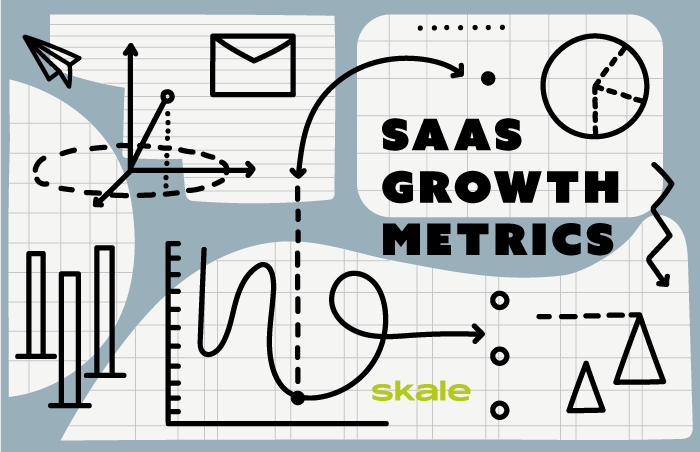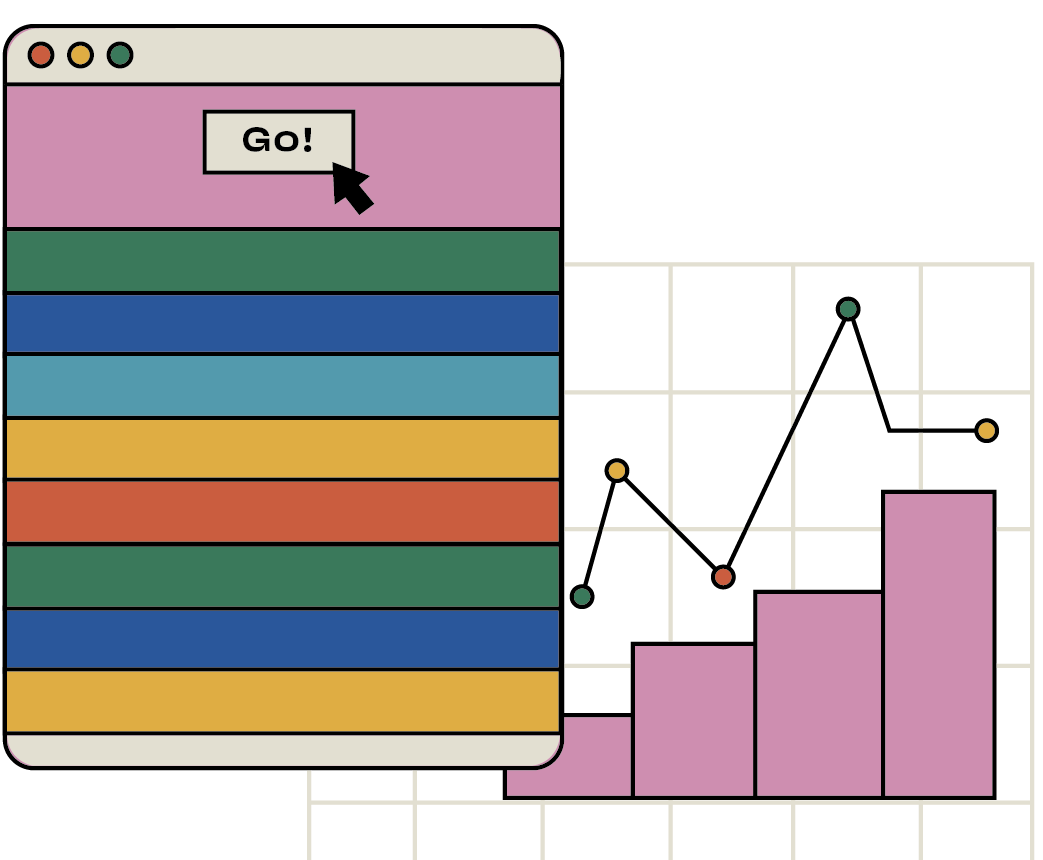
The best 8 SaaS marketing events to attend in 2024
In this comprehensive guide, we'll showcase some of the best SaaS marketing events in 2024 that you shouldn't miss.

As of 2021, the Software-as-a-Service (SaaS) industry was a 145 billion dollar market. In 2022, this is expected to rise to $172 billion. That’s some impressive growth.
We’ve listed the top 22 most important metrics for growing SaaS companies, and spoke with top SaaS experts to get you the most valuable SaaS marketing insights in the industry.
If you’re looking to track business growth but don’t know where to begin, this post is for you. Read on to discover the most important SaaS metrics to track your growth.

While there are several metrics that can analyze a SaaS business, not every metric is a great indicator of the growth of SaaS companies.
Here are the most important SaaS metrics you need to be tracking to monitor your business growth. With the help of some crucial SaaS marketing tools, these B2B marketing metrics will help you ensure you’re on the right path.
Let’s take a look.
Activation rate is one of the most important SaaS business metrics for understanding growth.
It gives you an idea of the percentage of users that successfully reach a predetermined milestone. This milestone is chosen by your SaaS marketing team and indicates that a user has begun using your product as you intended—not just signed up and stopped engaging.
You can track it by collecting data on new signups and activations for any given period, and then plugging into this formula:
Activation rate = Number of activated users / Number of new users x 100
While signups are crucial to help you see who has a strong interest in your product, activation is how to determine if users are actually engaging with your product. You can help convert signups into activations by providing personalized onboarding to new users.
Customer Acquisition Cost (CAC) is the amount you spend to acquire a single customer. It’s a great way to determine if your marketing tactics are working, and if the ROI is worth your effort.
Keep track of your new customers over a period of time and make sure you’re logging sales and marketing expenditure efficiently. Then, plug that info into this formula:
Customer acquisition cost = Total amount spent on sales and marketing / Total new customers acquired
CAC is an especially important metric for new companies where every sign up makes a difference. It helps assess the value of the acquisition and make correct adjustments going forward.
A few things to consider for your total amount spent on sales and marketing are:
Combined with customer lifecycle value (CLTV), CAC becomes an even more valuable metric. Talking of which…

Skale’s guide covers 16 high-impact strategies we use to reduce CAC and grow MRR for our clients
Read the guideCustomer lifecycle value (CLV) is the average monetary value a customer provides to your business throughout your business relationship. In simple words, it tells you what your average customer is worth to your organization—how much the average customer is spending on your product.
Alongside CAC, CLV helps you identify whether your business model is viable or not. The formula for calculating CLTV is:
Customer lifecycle value = Average revenue given by a customer per year / Average lifespan of a customer
If you’re at a startup, CLV can help you gauge whether your model will be profitable in the future or not. If you’re an established business, you can review your methods and make adjustments to get more from each customer relationship while spending less acquiring them—this often comes from honing down on retention strategies.
The average revenue per user is the amount of revenue generated on average from each customer. It’s an indicator of the profitability of a product, and can be calculated using:
Average revenue per user = Total revenue / Total users
ARPU is essential for calculating MRR—another important SaaS growth metric.
Monthly recurring revenue (MRR) is a key metric for SaaS businesses as they’re often—if not always—paid for on a subscription basis. It is the income that businesses can count on receiving every single month.
The formula for calculating MRR is:
Monthly recurring revenue = total number of paying users x average revenue per user (ARPU)
As a subscription-based service, it’s extremely important for you to track and compare revenue month-to-month. It’s an essential metric for growing businesses, however Jane Portman—co-founder of Userlist—warns of the dangers of relying too heavily on MRR:
“MRR could definitely be considered a vanity metric. It could grow well, but there could still be problems at the heart of the business.”
This insight reminds us to use these metrics together—not to pick just one and run with it—a North Star metric.

Discover the tactics these SaaS brands used to grow MRR, brand awareness & beyond
Get the insightsAnnual recurring revenue (ARR) builds on the foundation of MRR, and is used to measure percentage growth year on year. While MRR helps you analyze the highs and lows from month to month, the ARR helps you look at your year as a whole.
The formula for calculating ARR is simple:
Annual recurring revenue = 12 x MRR
Comparing ARR year-on-year gives you an idea of business stability and overall performance. MRR can quickly change, and ending the year on a low month doesn’t instill much confidence in the business or team. ARR gives you a better picture of business performance and growth. It also allows you to benchmark your progress against previous years.
Churn refers to the percentage of customers that stop doing business with your company over a set period of time. It’s not a fun metric—but it’s important for businesses to understand and rectify. You can calculate churn rate with:
Customer Churn Rate = Customers that leave during a period / Customers at the beginning of the period x 100
The idea is to minimize this rate by constantly engaging users and providing value. For example, Loom sends out email tutorials on new features to engage existing users.
Revenue churn quantifies the loss of existing customers by highlighting the revenue lost as a result of fewer customers.
Revenue churn = MRR at the beginning of period – MRR at the end of period / MRR at the beginning of period
Many experts consider revenue churn is the healthier metric compared to customer churn. In fact, Jane Portman from Userlist considers it the most important growth metric:
“For most businesses, net revenue churn would be a good indicator of healthy growth. It syndicates new customer growth, expansion revenue, and churn.”
You want to consider revenue churn alongside customer churn for a full overview of business churn.
Active trials are a great metric for businesses with a freemium business plan. It’s a good indicator of the success of your marketing efforts, and is especially helpful when testing out different messaging.
The formula for active trials is pretty straightforward:
Active trials = Σ all active subscriptions during a period
If this number is increasing from one period to another, it tells you you’re doing something right. Identifying that something is key for ongoing business growth. Failing to measure your active trials leaves you guessing about the success of your client acquisition efforts.
However, take active trials with a pinch of salt, you want to ensure someone is actually active in your product and hasn’t merely created an account.
A customer engagement score tells you how much and how often a customer engages with a product or an event by a business. Your engagement score will depend on the specifics of your product or marketing and what you consider engagement.
There are plenty of ways to get insights into your customer engagement score, but here’s a simple approach:
Customer Engagement Score = (w1*n1) + (w2 * n2) + … + (w# + n#)
Where w is the weight given to an engagement event and n is the number of times the event occurred.
It’s not uncommon for SaaS brands to try and recapture passive users by meeting them out of the app to pull them back in and engage with the platform. Pitch does a great job of this with their email marketing strategy.
Some businesses consider simply logging onto the service as engagement while others have a metric for support tickets being raised once or twice as the highest engagement. It helps you identify whether the methods you deploy work positively for your business or not.
Below are some other metrics that can also prove beneficial for understanding your business’ long-term growth.
One of the toughest tasks for SaaS companies is to turn free trials into paying subscriptions. Tracking the conversion rate is a great way to stay ahead of the curve and take steps towards bettering it.
You should strive for a 25% conversion rate for long-term success. Anything over 30%—give yourself a pat on the back.
Another great tool to know how well you are performing is to track the leads to customer conversion rate. Hundreds of leads mean nothing if none of them convert into paying customers.
It is also suitable for services that don’t have a trial, though you can track it otherwise as well. The idea is to improve the rate and get a better idea of how many leads you can expect to turn into paying customers.
Expansion revenue is the revenue that comes from existing customers. This could be via upselling, cross-selling, or any other addition to the original purchase. Here’s what Jane Portman from Userlist had to say about it:
“Expansion revenue is often overlooked. But it’s an amazing indicator of growth that happens without any marketing efforts.”
This metric is usually tracked by established SaaS companies. Performing well in this metric can help mitigate the loss suffered by way of churn.
Net Promoter Score (NPS) helps you understand how your existing customers feel and think about your product. You can use this information to improve your product.
Simply ask your existing customers a question—how likely they are to recommend the product to their friends or what they think you can improve on—and ask them to provide a rating from 1-10. You’ll then identify your detractors (0-6), passives (7-8) and promoters (9-10), and be able to take action to turn everyone into a promoter.
This metric helps you understand how well your product satisfies your customer. Product-market fit is when 40% of your customers would be ‘very disappointed’ if they no longer had access to your product. You get this information from a NPS survey.
With the help of this metric, you can work towards improving your SaaS product marketing, your service and your shortcomings.
This ratio helps in shaping your marketing plan as a whole. When you know the worth of average new customers and the amount you have to spend to acquire them, it becomes easy to gauge whether you are headed in the right direction or not. Once you know this, it becomes easier to send new customers further down the SaaS marketing funnel.
When we spoke to Luke Genoyer, Marketing Director at United World Telecom, they highlighted the importance of CAC/LTV for SaaS businesses:
“LTV/CAC is one of the most underrated growth marketing metrics in SaaS. Too many businesses are paying through the nose for new accounts and leads. For perspective, we’re a bootstrapped, self-funded company, and our LTV/CAC is around 6:1”
It also helps assure your investors and other third parties about the potential of your business strengths.
Social Capital founder Mamoon Hamid came up with the formula to analyze the growth of revenue over a period of time. This ratio pits revenue to churn and indicates the health of your revenue growth—not just its speed. It is especially helpful in directing your inbound marketing practices onto the right path.
This metric indicates how much money your company is actually making from your marketing efforts. However, your marketing efforts are again largely dependent on your marketing goals.
In case you’re looking for a better view of your SaaS marketing ROI, you want to consider your ROI alongside CAC and CLTV.

Calculate your ROI the easy way
Take hold of your SaaS marketing ROI with our free tracker
Download hereThese are leads that should be pursued ASAP—they’ve been verified as interested in making a purchase. However, how you identify these leads is entirely down to how your sales team operates and customer journey operates.
You ideally want to increase SQLs on a monthly basis—it’s another indicator of business growth and potential.
A good marketing playbook will recommend you categorize leads based on their lifecycle stage.
It is a tactic that saves you time and energy in the long run. It also helps you engage with them with personalized content.
An important metric for understanding business growth is your customer growth rate—how quickly you’re gaining new customers. It shows how effectively your business is growing and where you are lacking.
CAC payback period refers to the number of months it takes to earn back the money invested in acquiring customers. We spoke to Luke Genoyer from United World Telecom for more on this:
“Ideally, you want your customer acquisition costs to be paid back within 6-9 months. If you don’t have a firm grasp on this, your company might end up with a cash flow shortage.”
SaaS is an extremely competitive market in which you always want to be growing.
The above metrics help ensure your business is on the right growth path by helping you keep track of your business.
For more support identifying and tracking the growth metrics that matter for your organization, get in touch with the Skale team.
Growth metrics are used to measure a company’s growth and provide insights into overall business health. They help you benchmark goals, and better predict the growth of your business.
Growth metrics are important for SaaS because SaaS businesses are completely reliant on subscriptions and customers. Knowing the growth trajectory is important to sustain your business in the long run.
You track a company’s growth with growth metrics like:
– Activation rate
– CAC
– LTV
– MRR
– ARPU
Plus plenty others, like churn rate and NPS score. All of these metrics combined give a good overview of the health of your business.
A SaaS company should have a combined growth rate and profit margin of over 40% in order to be considered successful. This is known as the rule of 40.
Learn more about
SaaS Marketing

The best 8 SaaS marketing events to attend in 2024
In this comprehensive guide, we'll showcase some of the best SaaS marketing events in 2024 that you shouldn't miss.

7 Best SaaS Copywriting Agencies & Services in 2024
11+ SaaS copywriting agencies that will educate your audience, boost revenue, and nurture leads.

9 SaaS Content Marketing Agencies in 2024: Reviews & Pricing
Create content that generates serious revenue when you work with a SaaS marketing agency from this list.